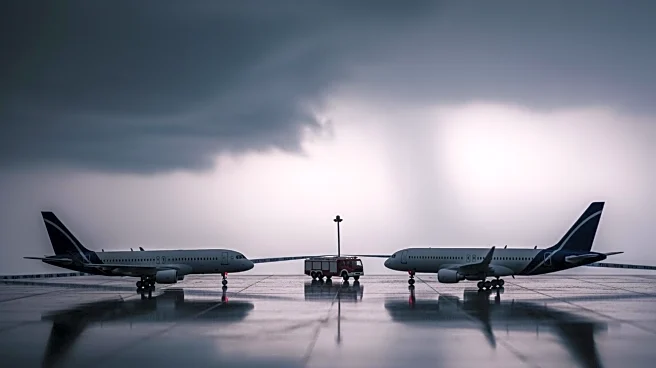What's Happening?
A near-collision incident occurred at Nice Côte d'Azur Airport involving two Airbus A320 aircraft from Nouvelair and EasyJet. The event took place late at night on September 21, 2025, under challenging
weather conditions marked by heavy rain and reduced visibility. The Nouvelair A320, performing flight BJ586 from Tunis, was cleared to land on runway 4L but mistakenly lined up with runway 4R, which was occupied by the EasyJet A320, performing flight U24706 to Nantes. The Nouvelair aircraft crossed the runway threshold at 50 feet above ground level and initiated a go-around only six seconds later, narrowly avoiding a collision by mere feet. The EasyJet flight was subsequently canceled, while the Nouvelair flight landed safely after the go-around.
Why It's Important?
This incident highlights critical safety concerns in aviation, particularly regarding runway alignment and communication between pilots and air traffic control. The close call underscores the importance of stringent safety protocols and the potential consequences of human error in aviation. The event could lead to increased scrutiny and potential changes in procedures to prevent similar occurrences. Airlines and regulatory bodies may need to reassess training and operational guidelines to ensure passenger safety, especially under adverse weather conditions. The incident serves as a reminder of the complexities involved in air travel and the need for constant vigilance to avoid catastrophic outcomes.
What's Next?
Following the incident, France's BEA has published a preliminary report, which may lead to further investigations and recommendations for improving safety measures at airports. Airlines involved might review their operational procedures and pilot training programs to address the factors contributing to the incident. Regulatory bodies could implement stricter guidelines for runway operations, especially in poor weather conditions. The aviation industry may see increased collaboration between airlines and air traffic control to enhance communication and prevent similar incidents in the future.
Beyond the Headlines
The incident raises questions about the adequacy of current aviation safety systems and the reliance on human judgment in critical situations. It may prompt discussions on the integration of advanced technology to assist pilots in navigation and decision-making. The event also highlights the ethical responsibility of airlines to prioritize passenger safety and the potential legal implications of near-miss incidents. Long-term, this could influence cultural shifts within the industry towards more proactive safety management and risk assessment strategies.











